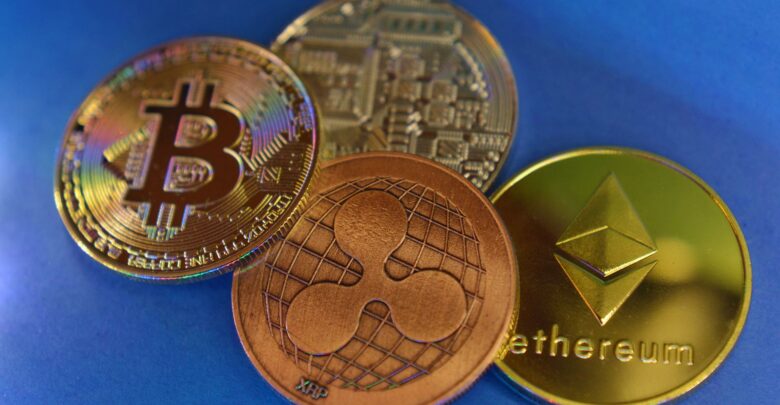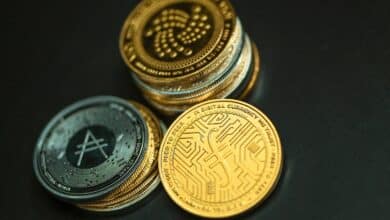Ethereum Vs Ripple: How Do They Differ?

Introduction
Most people around the world are only aware of Bitcoin as a cryptocurrency and blockchain. However, in reality, Bitcoin has inspired many companies and developers to issue thousands of new cryptocurrencies and blockchain networks. Two of the most prominent cryptocurrencies in the sector are Ethereum and Ripple.
When it comes to making an investment decision, cryptocurrency investors have a lot to consider about the underlying differences and key features of both Ethereum and Ripple-issued tokens and ecosystems.
A Brief History of Ethereum
Ethereum Foundation is an organized firm that was founded by core Ethereum developers Vitalik Buterin, Gavin Wood, Joseph Lubin, and Charles Hoskinson. In 2014, the entire core developers of Ethereum blockchain organized a crowdfunding event to collect financial support for the network and laid the foundation of a non-profit company called Ethereum Foundation. However, it is interesting to note that the Ethereum blockchain was invented much earlier than in 2014.
Vitalik Buterin was a Canadian developer who started to take an interest in blockchain in 2011 when he started to write for Bitcoin Magazine. He developed an opposition to centralized protocols as a child and was interested in creating a decentralized network. While studying Bitcoin, Buterin found out that the Bitcoin network did not allow the hosting of other decentralized applications for every developer.
With a new vision, he shared the blueprint for the Ethereum blockchain and was joined by other core developers. Buterin released a white paper for Ethereum in 2013 that described the baseline development of the network via a general scripting language. With the assistance of other all-core developers, the Ethereum network was released in 2014.
A Brief History of Ripple Labs
Ripple Labs is the main organization behind its native token called XRP. The project was started by a developer called Ryan Fugger, who was trying to create a decentralized payment network for banks that was not based on blockchains. Fugger’s project was called RipplePay, and he sold the project to Jed McCaleb, Arthur Britto, and David Schwartz in 2012. Under its new management, RipplePay was renamed as OpenCoin.
OpenCoin used the source code of RipplePay and its ledger-like payment system for creating private digital payment channels for commercial use. In 2013 OpenCoin was able to gather financial resources through two rounds of funding by big corporations. However, Jed McCaleb parted ways from the group to found a Stellar Lumens Network. He was able to take possession of around 8 billion XRP Tokens with him.
On account of regulatory issues, OpenCoin rebranded to Ripple Labs in 2013, and in 2015 it changed its name to Ripple. Since 2013, Ripple Network has decided to become an open-sourced and community-owned network. However, the company has continued to hold the largest holder of XRP tokens to date.
In 2016, Ripple became one of the few companies to acquire a BitLicense certification from the New York State Department of Financial Services. Ripple has also distanced itself from the management of XRP tokens by rebranding it under XRPLedger.
What is the Difference Between Ethereum and Ripple?
Ethereum and Ripple tokens are fundamentally different cryptocurrencies, and they have experienced a diversified development phase. The motivations of the developers who have worked on both currencies and blockchains are widely dissimilar.
Furthermore, the circumstances and the progression stages for both networks have also played an important role in shaping the networks that led them in varied directions. Keeping that in mind, here are some of the fundamental differences between Ripple and Ethereum Network:
- Goals
- Technical
- Functional
- Token Standards
- Forks
- Distribution
- Consensus
- Scalability
- Regulations
- Pricing and Ranking
- Utility
- Gas fees
- Power Intake
- Burning
Goals
The main aim of the Ethereum founders was to create a network that could provide an alternative for centralized financial and other digital enterprises. Ethereum’s mission was to ensure that the developers had a platform where they could create decentralized applications to perform different functions and promote projects that were community-owned and decentralized.
Ethereum has transformed into a decentralized protocol that can host thousands of dApps and crypto tokens on the network, and developers can join the network and create their projects based on smart contracts.
On the contrary, Ripple’s conception was a result of facilitating corporate entities a way to conduct their financial transactions with higher efficiency. At its base, Ripple is not a decentralized entity; rather, it plans to offer financial services for private and government digital payment sectors. With time, Ripple has incorporated a blockchain-based payment network, and it depends on consensus for data manipulation.
Technical
The Ethereum network is the first blockchain network in the world to deploy smart contracts. Smart contracts are an automation protocol for blockchain applications that are triggered by a preset requirement. On the other hand, the baseline Ethereum network also inherited PoW or Proof-of-Work Consensus model from Bitcoin. Ethereum developers have introduced ERC-20 or Ethereum Request for Comments which works as a technical standard.
The native token of Ripple, unlike Ethereum and Bitcoin, is premined. Ripple has adopted a private consensus algorithm based on 39 entities to ensure that it does not require any mining. XRP tokens work as an exchange medium between different fiat currencies and also offer liquidity.
Functional
The Ripple network is a centralized and open-sourced blockchain network that is used for making digital payments. The design of the Ripple network allows for conducting cross-border payments with minimal fees. The underlying currency of the Ripple network, namely XRP, works as a medium of exchange between transaction parties to enable conducting financial payment by converting it into XRP before and after payment.
On the other hand, the Ethereum network is capable of transferring more than just cryptocurrencies. The blockchain has an automated transaction verification system called smart contracts and a unique execution code. Ethereum works as a hosting network or baseline operating system for other decentralized applications but offers a greater level of security and downtime risk.
Token Standards
Ethereum network has introduced EIP or Ethereum Improvement Protocol as a way to standardize all the decentralized applications and cryptocurrencies that it is hosting. EIP is a document that defines in detail the minimum requirements for technical qualifications for developers. EIP protocols can dictate changes on projects based on APIs, source code, protocol standards, and contract conditions.
Some of the most popular EIP types are Core, Standard Track, Networking, Interface, Informational, Meta, and ERC, among others. On the other hand, Ripple uses XRPLF and XRPPL standards to allow it to become integrate new digital payment applications, private payment networks, and new banking channels.
Forks
In 2015, the Ethereum network tested a new decentralized protocol called DAO, or Decentralized Anonymous Organization. DAOs are a self-governing governance protocol that can hold or release funds based on a defined rule within that smart contract.
The DAO introduced by Ethereum in this instance was responsible for automating the process of selecting viable new projects on the Ethereum network and awarding them with funds contributed by the community.
However, things failed to go as planned, and as a result, Ethereum was hacked with the theft of a $100 million community contribution. At this stage, the public trust in Ethereum dwindled, and it created a division within the Ethereum community. Consequently, the Ethereum community voted for a fork that could return the stolen funds and create two Ethereum forks called Ethereum Classic and Ethereum.
Thus far, Ripple has not experienced a hack attempt. However, the company has faced a lot of lawsuits and regulatory issues. As a result, Ripple has kept rebranding its blockchain ventures, eventually resorting to rebranding Ripple blockchain as XRPLedger in an attempt to claim that it is a community-owned project. However, if Ripple Labs opts to dump its massive XRP holdings, XRPLedger can opt for a fork through community consensus.
Distribution
The first-ever Ethereum release and sales event were called Frontier, and it was arranged by Ethereum developers to collect funds. During Frontier, Ethereum developers sold Ether among prospect investors and raised $18 million in 2015. In 2017, Ether’s value increased by 13,000. In addition to other cryptocurrencies, as a result, the token gained a lot more traction among investors around the world.
Bitcoin founder Satoshi Nakamoto originally mentioned the Ripple network during one of his/her rare online entries. Nakamoto claimed that Ripple has the potential to create a digital payments system that does not depends on a central server. Despite making decentralized claims, Ripple owns 55 billion out of 100 billion total supply of XRP.
Consensus
Ripple uses a PoS consensus model, which means that all the 100 billion XRP tokens have already been mined. At the time of the first public debut of XRP, Ripple owned only 7 billion tokens. However, now its escrow account holds around 55 billion XRP tokens making it the largest holder. Ripple has introduced other digital payment systems like XCurrent to facilitate banks.
The Ethereum network started with the PoW consensus model, following in the footsteps of Bitcoin. However, the Ethereum developers have been working on Ethereum 2.0, which is a new Ethereum upgrade that aims to switch the network to a private consensus algorithm based on 39 entities and rejoin it with the Ethereum Classic network. However, the Ethereum 2.0 protocol has been under development for years.
Scalability
Scalability is the quality of a digital program to adapt to its increasing data input and traffic management. That Ripple network is designed to assist commercial transactions for banks and other financial enterprises, ergo the network can support 1,500 transactions per second. Furthermore, the network also does not suffer from inflated transaction fees on account of scalability.
Scalability, or the ability to perform transactions per second for Ethereum, is 100 times weaker than the Ripple network. Ethereum can process one transaction in two minutes. The average block production and execution time on the Ethereum network is 10 minutes which is even bigger than Bitcoin’s estimated 12 seconds.
In terms of regulations, Ripple has felt the burn of backlash time and again since its conception. Ripple has faced three major lawsuits. In 2015, FinCEN imposed a fine on Ripple worth $7 million for the violation of the Bank Secrecy Act and a failure to comply with AML or anti-money laundering practices. In 2018, Stewart Hope, an English Parliamentarian, questioned Ryan Zagone from Ripple about XRP’s role in digital security.
In 2017, Ripple was sued by R3, another digital payments platform, for specific performance based on an option agreement. R3, which has partnered with Ripple network for a while, demanded $1 billion in compensations. In 2020, Ripple faced prosecution from the Securities and Exchange Commission of the United States for violation of Investor protection laws claiming that Ripple unlawfully collected $1.3 billion using XRP as digital security without adequate disclosure.
The SEC lawsuit is still going on after two years of procession. Ripple executives have brought up the argument that SEC is biased against Ethereum and Bitcoin, which work the same as XRP tokens but has been unable to win the case to date.
On the other hand, Ethereum Foundation has not faced any major or minor lawsuits thus far. During Ripple proceedings, SEC prosecutors admitted that the federal agency has thus far never opened any investigation into Ethereum.
Pricing and Ranking
During its peak, Ripple token XRP reached an All-time high of $2.759 during the 2018 Bull Market Run. At present, the price of the token has dropped to $0.318871 considering the ongoing Crypto Winter. Its market cap has fallen to $15.43 billion, ranking it the 7th largest cryptocurrency in the world by capital.
Ethereum Classic, ETC, ATH was recorded at $134.80 in 2021 when the speculation around the PoS transition earned it a lot of traction from investors. ETC is listed on 84 cryptocurrency exchanges around the world. At press time, it is trading for $14.47 with a market cap of $1.96 billion. ETC is ranked as the 32nd top cryptocurrency in the world by capital.
Ethereum or ETH managed to reach ATH of $4,812 around eight months ago during the last cryptocurrency bull market run. At present, ETH is trading for $1.027 per unit, and it has experienced an 8% price depreciation in the last 24 hours. The current market cap of Ethereum is valued at $124.78 billion, which has allowed the cryptocurrency as the second top crypto market cap contributor after Bitcoin.
Utility
The main use case for Ripple is to act as an alternative to the present SWIFT banking network for conducting digital transactions. Besides XRP, Ripple has introduced another digital payment service called XCurrent. XCurrent works as an open-sourced digital payments network and messaging application for commercial and financial enterprises. Meanwhile, XRP functions as a medium of exchange for fiat currencies to enable digital transactions.
The use cases of the Ethereum network are more than just a cryptocurrency transfer or hosting network. Ethereum networks can host and generate new decentralized applications and tokens.
Ethereum hosts popular NFT collections such as Cryptopunks and Bored Ape Yacht Club. It is also home to dApps like Decentraland, The Sandbox, Axie Infinity, etc. Ethereum can provide an operating basis for decentralized exchanges and markets like UniSwap, Aave, Curve Finance, and MakeDAO, among others.
Gas fees
The average transaction fee on Ripple’s XRPLedger is estimated at 0.00001 XRP. However, the gas fees can increase on account of increasing traffic on the network. Meanwhile, transaction fees have remained one of the biggest issues that the Ethereum network suffers. At its lowest, Ethereum gas fees were recorded at $2.90 per transaction.
However, even when the fees on the network start to drop, investors are not happy since it signals a rapid fall in transaction volume and Ethereum market value. On the other hand, peak trading volume per transaction fee can rise as high as $50, which results in investors’ option to leave the network in the search for other alternatives.
Power Intake
Data from Digiconomist reports that Ethereum mining requires 112 terawatt-hours (average per year) of energy which is equivalent to the electricity consumed by an average American household for more than nine days.
In comparison, the XRPLedger network requires only 0.0079 Kilowatt-hour for every transaction. According to a TRG Datacenters report, XRPLedger is one of the cleanest and greenest cryptocurrency networks in the world. However, the report does not account for the amount of energy that is consumed by the centralized banking and financial enterprises that use XRPLedger for conducting financial transactions.
Burning
A burn or null address on a blockchain is a place where the investors can send their tokens to burn or permanently ousted from the circulatory supply. There is an EIP-1559 burn protocol on the Ethereum network. Statistics from Watch the Burn tracker suggest that to date, Ethereum has sent 2 billion ETH tokens to the burn address as a way to maintain supply and deflate the currency. EIP-1559 standard provides guidelines for other token projects to create a null address.
On the other hand, Ripple has faced a considerable amount of criticism for its massive supply of 100 billion XRP tokens. Ripple has a built-in burning protocol called CRYPTO: XRP. Ripple executive claims that Ripple tokens that are paid as a transaction fee are burned during every transaction. According to estimates, around 1.8 million XRP are burned per year. Ripple CTO David Schwartz has claimed that the XRP community can force Ripple to burn 48 billion XRP with an 80% community vote.
Conclusion
Many people assume that most cryptocurrencies are just digital currency that is an alternative to fiat currencies. However, depending on its use cases and design, every cryptocurrency and blockchain project garners massive differences from each other.
Ripple and Ethereum blockchains are two of the most popular digital currency project after Bitcoin, but despite using the alpha blockchain as the central idea, both currencies have widely variable functionalities that also create different prospects for both blockchain projects.
Tokenhell produces content exposure for over 5,000 crypto companies and you can be one of them too! Contact at info@tokenhell.com if you have any questions. Cryptocurrencies are highly volatile, conduct your own research before making any investment decisions. Some of the posts on this website are guest posts or paid posts that are not written by Tokenhell authors (namely Crypto Cable , Sponsored Articles and Press Release content) and the views expressed in these types of posts do not reflect the views of this website. Tokenhell is not responsible for the content, accuracy, quality, advertising, products or any other content or banners (ad space) posted on the site. Read full terms and conditions / disclaimer.







